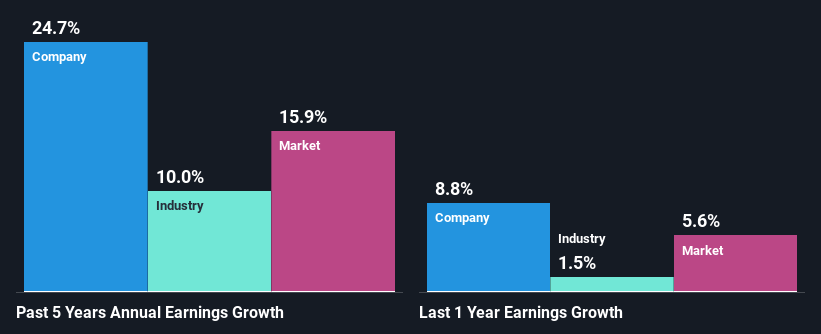Is Becton, Dickinson and Company's (NYSE:BDX) Recent Stock Performance Influenced By Its Financials In Any Way?
Becton Dickinson's (NYSE:BDX) stock up by 6.6% over the past three months. We wonder if and what role the company's financials play in that price change as a company's long-term fundamentals usually dictate market outcomes. In this article, we decided to focus on Becton Dickinson's ROE.
Return on equity or ROE is an important factor to be considered by a shareholder because it tells them how effectively their capital is being reinvested. In short, ROE shows the profit each dollar generates with respect to its shareholder investments.
See our latest analysis for Becton Dickinson
How To Calculate Return On Equity?
Return on equity can be calculated by using the formula:
Return on Equity = Net Profit (from continuing operations) ÷ Shareholders' Equity
So, based on the above formula, the ROE for Becton Dickinson is:
6.4% = US$1.6b ÷ US$26b (Based on the trailing twelve months to March 2023).
The 'return' is the income the business earned over the last year. Another way to think of that is that for every $1 worth of equity, the company was able to earn $0.06 in profit.
Why Is ROE Important For Earnings Growth?
Thus far, we have learned that ROE measures how efficiently a company is generating its profits. Based on how much of its profits the company chooses to reinvest or "retain", we are then able to evaluate a company's future ability to generate profits. Assuming all else is equal, companies that have both a higher return on equity and higher profit retention are usually the ones that have a higher growth rate when compared to companies that don't have the same features.
Becton Dickinson's Earnings Growth And 6.4% ROE
When you first look at it, Becton Dickinson's ROE doesn't look that attractive. A quick further study shows that the company's ROE doesn't compare favorably to the industry average of 9.8% either. In spite of this, Becton Dickinson was able to grow its net income considerably, at a rate of 25% in the last five years. We reckon that there could be other factors at play here. Such as - high earnings retention or an efficient management in place.
Next, on comparing with the industry net income growth, we found that Becton Dickinson's growth is quite high when compared to the industry average growth of 10% in the same period, which is great to see.
Earnings growth is a huge factor in stock valuation. The investor should try to establish if the expected growth or decline in earnings, whichever the case may be, is priced in. Doing so will help them establish if the stock's future looks promising or ominous. Is BDX fairly valued? This infographic on the company's intrinsic value has everything you need to know.
Is Becton Dickinson Efficiently Re-investing Its Profits?
The high three-year median payout ratio of 68% (implying that it keeps only 32% of profits) for Becton Dickinson suggests that the company's growth wasn't really hampered despite it returning most of the earnings to its shareholders.
Moreover, Becton Dickinson is determined to keep sharing its profits with shareholders which we infer from its long history of paying a dividend for at least ten years. Our latest analyst data shows that the future payout ratio of the company is expected to drop to 27% over the next three years. As a result, the expected drop in Becton Dickinson's payout ratio explains the anticipated rise in the company's future ROE to 16%, over the same period.
Conclusion
Overall, we feel that Becton Dickinson certainly does have some positive factors to consider. That is, quite an impressive growth in earnings. However, the low profit retention means that the company's earnings growth could have been higher, had it been reinvesting a higher portion of its profits. Having said that, the company's earnings growth is expected to slow down, as forecasted in the current analyst estimates. To know more about the latest analysts predictions for the company, check out this visualization of analyst forecasts for the company.
Have feedback on this article? Concerned about the content? Get in touch with us directly. Alternatively, email editorial-team (at) simplywallst.com.
This article by Simply Wall St is general in nature. We provide commentary based on historical data and analyst forecasts only using an unbiased methodology and our articles are not intended to be financial advice. It does not constitute a recommendation to buy or sell any stock, and does not take account of your objectives, or your financial situation. We aim to bring you long-term focused analysis driven by fundamental data. Note that our analysis may not factor in the latest price-sensitive company announcements or qualitative material. Simply Wall St has no position in any stocks mentioned.
Join A Paid User Research Session
You’ll receive a US$30 Amazon Gift card for 1 hour of your time while helping us build better investing tools for the individual investors like yourself. Sign up here

 Yahoo Finance
Yahoo Finance 
